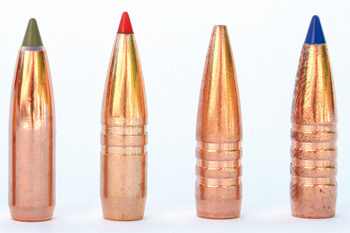Lead alternatives for deer stalkers
Investigating lead alternatives for deer The lead versus non-toxic debate is nothing new to those of us actively involved in…
Win CENS ProFlex DX5 earplugs worth £1,149 – enter here

But isn’t copper toxic?” asked a friend. He is a staunch defender of lead ammunition. In a discussion about centrefire rifle ammunition, I suggested he read Megan Rowland’s recent piece in Shooting Times.
She gave a detailed account of using copper bullets for stalking and indicated that this may be the way forward. My lead-head friend is unconvinced.
As it happens, he’s right on one thing; copper can indeed be toxic. But here’s the kicker; a certain amount of copper is actually essential for good health. It is only when it is present in the body above a certain level that it becomes problematic. And that’s a key distinction from lead, which has no safe limit whatsoever.
Lead begins causing damage in even the tiniest amounts. It is a metallic poison that starts doing its nefarious work from the moment it enters your bloodstream. Copper, on the other hand, is an essential trace element. It is actually added to some types of livestock feed.
In order to be capable of causing damage, lead has to be in what the boffins call a bioavailable form. You can hold a chunk of metallic lead in your hands without suffering any detrimental effects. Like that, it’s pretty inert — though you would be unwise to lick your hands afterwards. To be bioavailable, lead typically has to be present in small particles with a high surface area, capable of being absorbed.
This could occur if spent lead pellets are in a bird’s gizzard, where they are being ground up and eroded by gastric fluid. Or if lead fragments are lodged within the gut, or near capillary blood vessels in muscle or other tissue.
A conventional lead-cored rifle bullet is designed to expand and deform as it travels through a deer. If you recover the fired bullet and weigh it, you will often find that is has lost at least 30% of its unfired weight — sometimes more. And where do you think all that missing lead has gone?
A lead bullet smashing through flesh at high velocity spins off a tornado of fragments. Many of these particles are dust-like and invisible to the naked eye. They can travel as far as 18in beyond the wound channel. A study by the Minnesota Department of Natural Resources, in the US, surveyed lead fragments in commercially processed venison. In a sample of 1,029 packages of ground venison and 209 packages of whole-cut venison, 27% of the ground and 2% of the whole-cut meat was found to contain lead fragments.
Investigating lead alternatives for deer The lead versus non-toxic debate is nothing new to those of us actively involved in…
For advocates of lead ammunition, the arguments have become academic. The leaders of our major shooting and countryside organisations have…
Lead in carcasses can also have devastating results on scavenging wildlife. In the US, lead poisoning from hunter-killed deer and elk remains was found to be the main cause of mortality for the critically endangered California condor. That state has now banned the use of lead bullets for hunting. Copper is being used instead. Copper bullets kill just as well as lead, but they kill only once.
A key feature of monolithic copper bullets is their remarkable weight retention after firing — often approaching 100%. Like lead bullets, copper bullets are often designed to expand. Many feature a nose channel to ensure the metal folds back into “petals”. But they tend not to throw off tiny bits of metal.
In simple terms, copper is much less toxic
than lead, and copper bullets produce vastly fewer bioavailable fragments anyway.
Get the latest news delivered direct to your door
Discover the ultimate companion for field sports enthusiasts with Shooting Times & Country Magazine, the UK’s leading weekly publication that has been at the forefront of shooting culture since 1882. Subscribers gain access to expert tips, comprehensive gear reviews, seasonal advice and a vibrant community of like-minded shooters.
Save on shop price when you subscribe with weekly issues featuring in-depth articles on gundog training, exclusive member offers and access to the digital back issue library. A Shooting Times & Country subscription is more than a magazine, don’t just read about the countryside; immerse yourself in its most authoritative and engaging publication.

